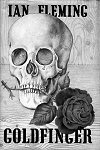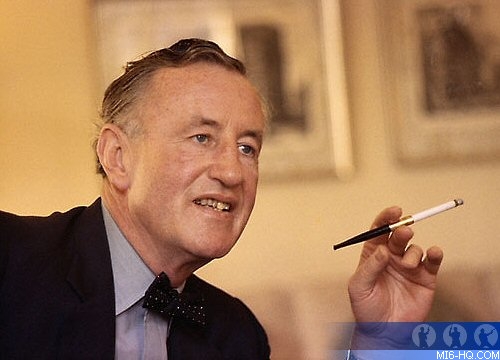|
|
|
 |
| |
As "Goldfinger" celebrates 50 years since original
publication this week, MI6 reviews Ian Fleming's
seventh James Bond novel... |
|
Goldfinger: Reviewed
24th March 2009
Goldfinger, the seventh of Ian Fleming's James
Bond adventures, was first published on March 23 1959 by Jonathan Cape. The novel features a larger than life villain whose love of gold is all consuming, a henchman with a steel rimmed hat who is about as unpleasant as they get and a Bond girl whose name shows Fleming at his most playful. It also features a gold painted girl, a gold Rolls Royce and the gold depository of the United States - every facet of Fleming's latest novel carried the hallmark of gold.
The story starts at Miami Airport, when James Bond is in the bar, waiting for his flight to be called and reflecting on the mission he's just completed and his life in general. Bond's thoughts are disturbed by a man he vaguely recognises, who turns out to be a rich American named Du Pont he first met while at Royale-les-Eaux in "Casino Royale" [1953]. When their flight is cancelled Du Pont tells Bond that he has a proposition for him, which would be well paid, and takes him to dine on stone crabs and pink Champagne at Bill's on the Beach.
Right: First Edition "Goldfinger" cover by Richard Chopping |
|
 |
Bond is offered $10,000 for the trouble of finding out how Du Pont is constantly beaten at cards by his opponent, a certain Mr Auric Goldfinger. This opportunity is one that 007 takes willingly - a taste of "the easy life" for which Bond was yearning for whilst at the airport. Of course Bond finds exactly how Goldfinger is cheating and forces him to pay Du Pont back. And when Bond returns to London he is astounded to find that his next mission involves Goldfinger and immediately sets about meeting him again. "'Whoryou? Whatyouwant?' The girl's hand was up to her mouth. Her eyes screamed at him. 'I've got what I want. Don't worry. It's all over now. And my name's Bond. James Bond.'"

Above: Author, Ian Fleming... |
The book is in three acts - "Happenstance", "Coincidence", and "Enemy Action" -
and early on in the book Fleming shows what a master he is
of first card games and then later golf. After Miami, Bond
finds himself assigned to find out how Goldfinger is smuggling
large amounts of gold. Following a golf match at Sandwich,
intricately described by Fleming, Bond tails Goldfinger's Rolls
Royce through France to his factory in Switzerland in an Aston
Martin DB III; incidentally the only time the marque appears
in the novels. Captured by Goldfinger, 007 soon finds himself
back in the US and in the middle of a plot to rob America's
gold reserves at Fort Knox in order to corner the world bullion
market with the aid of some American Gangsters, including the
alluringly named Pussy Galore.
| |
|
"'Mr Bond, the word "pain" comes from the Latin poena meaning "penalty" - that which must be paid. You must now pay for the inquisitiveness which your attack upon me proves, as I suspected, to be inimical.'"
Fleming had started to become tired
of writing his annual Bond adventure by now and complained
to friends about having run out of ideas, perhaps one
of the reasons that after a good beginning and middle
section the story seems to run out of steam towards the
end with the climax that feels all rather rushed. Some
critics have pointed a number of flaws in the plot, but
perhaps the most obvious is that
he fails to convince the reader that the entire gold
reserve held in Fort Knox could be removed so quickly.
This was remedied in the film when,
rather than steal the gold to corner the market, Goldfinger plans
on irradiating it instead.
Left: 2008
artwork by Michael Gillette. |
Another element of this novel that is startlingly
different from the film is the villain's penchant for Gold. Fleming
describes his obsession in considerable detail and many critics
have picked up on the intimated sexual gratification Goldfinger
gains from his precious metal. Overall, "Goldfinger" is a more ponderous
Bond novel with moments of intricate focus and detail - often
at the expense of the plot. However, the devil is truly in the
details; as well as being one of the best literary characters
to come from Fleming's pen, Goldfinger is one of the most manic
and foolhardy villains Bond encounters in the nine years the
author was writing his 007 adventures. MI6 Rating 
Capsule Reviews
"Fantastic ... Nobody else does this sort of thing as well as Mr Fleming"
- Sunday Times "Goldfinger the "formula" for the rest of his best Bond books. We have the outlandish villain, bizarre methods of death, exotic locations, the melodramatic names (Goldfinger, Pussy Galore), and the insider's knowledge. Great escapism.
- OMDB Ian Fleming's Goldfinger, the seventh title in his popular series, is partly just a darn good read and partly a sort of cultural primer. Set (as are the other Bond novels) in the bygone mid-century world of the British upper class, where a man's golf shoes were a reliable indicator of his character, the book is replete with card games, golfing and champagne suppers. The cars are superb, the martinis are dry, and even the villains are gentlemen - although not as much so, of course, as Bond. The book is full of the fantastic gizmos, intricate plots and the dazzling action scenes that Fleming made famous.
- April Chase, Curled Up Voice your opinion on Ian Fleming's
7th James Bond adventure now: submit a fan review online at the
Keeping the British End
Up discussion boards. If you do not have
an account yet, its free to sign up. Selected reviews will be
published on mi6-hq.com in the near future.
Related Articles
 Goldfinger Coverage
Goldfinger Coverage
 Ian Fleming Centenary Ian Fleming Centenary Many thanks to David Leigh. | |